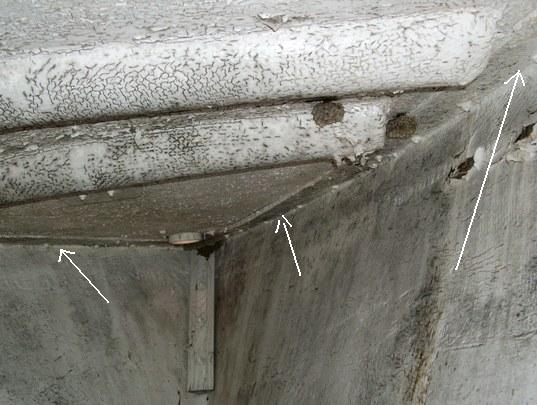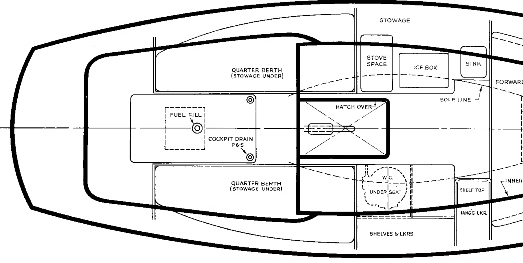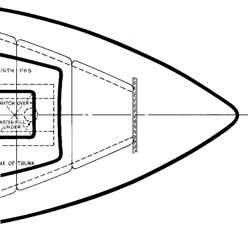|
January 12, 2009 The Dolphin 24 Brain Trust (names withheld for security reasons) has been working on trying to properly identify the builders of some of the early Dolphins - boats built in 1960 - 1965. In this period they were all O'Day boats but built by various O'Day's contractors - Marscot Plastics in 1960, Lunn Laminates in 1961, O'Day in 1962 forward (they officially acquired the Marscot plant in late 1960), J.J. Taylor and Sons, Toronto, Tripp and Sons, plus homebuilders using hulls and parts supplied by O'Day (like John Shumaker, Yankee's founder who built his first Dolphin 24, Yankee on O'Day hull # 71), and perhaps even others.
The Dolphin 24 was initially marketed by O'Day in 1960, then US Yachts in 1961-1963, then back to O'Day. When registered, these boats were usually listed as O'Day Dolphins most likely in the year they were bought but maybe the following year if a late year purchase, and in any event, the date being not necessarily the year built - and the actual builder may not have been identified, or even known by the first owner. Forty plus years later, without a nameplate identifying the builder, various owner changes masking original details, re-registrations by new owners with erronious file data, winter tarps frustrating off season investigations, etc, this effort can be challenging..
Our goal here - using physical characteristics visible from photos, the keen eyes of our staff marine architects, and employing the 'scientific method' - construct a theory based on known facts - and continually revise the theory, if necessary, on receipt of new information.
The following chart identifying these characteristics will be updated as new information arrives and theory evolves. As usual readers are encouaged to provide editorial comment, correction, new theories, etc.
| Builder Production Group |
Marscot 1960 |
Lunn 1961 |
1962+ O'Day and Tripp 1965 |
| CLASS HULL NUMBERS |
1 thru 29? |
L200 thru L226 |
41-70; Tripp 5 boats inc #75 |
| HULL CONSTRUCTION |
|
|
|
| Hull mold |
split mold, parting line, stress cracks |
Molds joined |
Used Lunn modified molds? |
| Sheer clamp |
FG encased wood |
FG flange / bolted |
FG flange / bolted |
|
|
|
Bow 'parting line' and gelcoat cracks |
|
Passage sheer clamp, fiberglass flange wrapped around a wood core. The bolts are toe rail bolts which, along with genoa track bolts, stanchion plate bolts and chainplates were/are, a source of water penetration because of poor sealing. Over time the wood core rotted. |

We have been looking for a good picture of the Lunn Laminates' sheer clamp, and on March 22, 2010, we found one - Jim Oppy's Wisp
|
On March 28, 2010 we received a picture of Windsong's interior (O'Day # 66) and the owner's description of her sheer clamp:
"the clamp consists of a 3" hull lip integral with the hull moulding , a mating section on the deck moulding, topped by a teak strip and through bolted every 6" or so with 1/4" bolts. - same as that currently used on J 24's"
Assuming this was not a previous owner fix, and we don't think so, this is an example of the O'Day sheer clamp system used when they started up production after the Lunn sub contract.
|
| Builder Production Group |
Marscot 1960 |
Lunn 1961 |
1962+ O'Day; Tripp |
| CLASS HULL NUMBERS |
1 thru 29? |
L200 thru L226 |
41-70; Tripp 5 boats inc #75 |
| DECK and FITTINGS |
|
|
|
| Bridgedeck |
Same height as seats |
like Marscot |
low bridgedeck |
| Companionway |
narrow, no taper |
like Marscot |
wider, tapering outboard |
| Main hatch |
narrow, fiberglass except #1 |
like Marscot |
wider hatch, fiberglass |
| Cockpit Coaming |
Mahogany |
Teak |
FG molded w/wood cap |
| Hand rail |
Mahogany clam shape |
Teak clam shape |
Teak slotted |
| boom crutch |
yes - port aft house |
None |
None |
|
David Drigger sent in some great pictures of his Cicerone, O'Day/Marscot #19 built in 1960 showing the boat pre restoration. In this picture we can see the 'high bridge deck, even with the cockpit seats, the small companionway and fiberglass main hatch, the boom crutch on the aft side of the house, the mahagony coaming, and the clam handrail on top of the house. Passage does not have a boom crutch now, but did. The filled screw holes are visible. |
One of the identifying characteristics is the type of wood used in the external trim. Mark Steinhilber (Rascal) put together the following interesting description - added January 15, 2010
Wood Trim - Mahogany vs. Teak: The wood used on the Marscot boats was mahogany which holds a reddish hue and needs to be varnished instead of oiled like teak. It does not stand up as well as the teak outside without the varnish and has very little long continuous grain visible. Instead, real Mahogany (Honduran, not Phillipine, not ribbon grained version either), has a consistent tiny black fleck of grain, much like 3 day beard stubble. Teak stands up to weather better, contains it's own oils and will turn a silver grey. It can be kept up with chemical cleaning and lightening and then be oiled to keep its more yellow brown color as compared to Mahogany. When you sand Mahogany, it appears red, when you sand teak, it appears more yellow-brown without any red tint.
The Lunn teak toe rails were a little wider than the Marscot built ones and the clam rail on the roof was a more squared looking clam rail. Compare Cynosure/Wisp to Sloop Du Jour, Passage, or Cicerone. The newer O'Days eventually showed up with a more common slotted handrail. On Rascal, we slotted our existing clam shape handrail to give better handholds. The spacing of the slots was uneven because of where the screws were located. It looks like Stan Barnes did the same thing to Shaman's clam rails. (boatyard photo.) I clearly remember that difference between Rascal and the (Lunn built) Her Ladyship's wood trim. I worked on both in the Boatyard in Niantic around 1971 or 1972, wet-sanded and painted bottoms and stepped their masts etc. both had aluminum rudders.
| Builder Production Group |
Marscot 1960 |
Lunn 1961 |
1962+ O'Day; Tripp |
| CLASS HULL NUMBERS |
1 thru 29? |
L200 thru L226 |
41-70; Tripp 5 boats inc #75 |
| DECK and FITTINGS (cont) |
|
|
|
| forward portlight height |
High hulls 1 - 7, none hull 29 |
|
|
| portlight frames/shape |
small rect. aluminum, except #1 |
small, Cast aluminum frame |
larger oval shape |
| Raised FG mast step |
no |
no |
Yes Hull 41, 56+ |
|
This is Marscot/O'Day Hull #1 with the (really) high front portlight and the molded, fiiberglass reinforced portlight frames per the 1960 sales brochure. Passage, #10 has original? cast aluminum portlight frames. Note the clam hand rail on the cabin top and the wood main and fore hatch. |
Early Dolphin's had their masts stepped on the house using various types of step plates, often hinged, so masts could be stepped and unstepped by the owner at the dock or on the trailer. Below are examples - left, Peggy Benkard's early 1962? O'Day Sloop du Jour (note early Sudbury lexan ventilator - brown from long UV exposure); right a close up of Casandra Rose's fiberglass molded raised mast step. Beneath these photos are examples of early mast step hinges used on Marscot boats.
|
|
Sloop du Jour - non hinged mast plate |
Casandra Rose's molded mast step |
|
|
|
Passage's hinged mast step |
| Builder Production Group |
Marscot 1960 |
Lunn 1961 |
1962+ O'Day; Tripp |
| CLASS HULL NUMBERS |
1 thru 29? |
L200 thru L226 |
41-70; Tripp 5 boats inc #75 |
| INTERIOR |
|
|
|
| Layout |
Daysailer/Cruiser/Racer option |
like Marscot boats |
similar to earlier Marscots |
| Wood and finish |
varnished mahogany |
white painted plywood |
varnished mahogany |
| galley location and type |
Port side with icebox and inset sink |
like Marscot boats |
|
| Inside mast support arch |
open interior |
|
|
| head location |
Stbd under settee |
Stbd, fwd of BHD |
stbd under settee |
 
Above is the March, 1960 O'Day sales brochure centerfold (I am still working on 2 picture splicing technology). The sink in inset on port, a top lid ice box then a shelf at at a lower level for a stove. On some boats a swing up table, (an option?) is mounted on the front of the ice box. Marscot typically had the aluminum trimmed finish pieces on corners and edges. The head is located opposite under the starboard settee. The following photo of Cicerone's interior shows this perfectly. Note the difference in portlights.
|
|
Cicerone # 19 |
Casandra Rose # 56 |
|
|
March 1960 O'Day Plan - main cabin |
|
Tripp boats were built in 1965 with all major parts supplied by O'Day so these boats are 'identical' to the 1962 and later built O'Day Dolphins. To date we have only Jay Picotte's Recovery, as an example of boats built by Tripp. Below left is a photo of the Tripp built Recovery before Jay replaced all her portlights with bronze portholes. Also, Recovery has molded fiberglass combings, athough you would never know it from this picture. Jay is a boat craftsman who taught boat building at the International Yacht Restoration School (IYRS) in Newport and is now the Curator at the Newport Museum of Yachting. He decided one day to faux paint his coamings to look like wood. Compare these photos below = Recovery on the left and Casandra Rose on the right.
That wood trim piece makes Recovery's front port light look higher than Casandra Rose's?
To be continued
|
|
